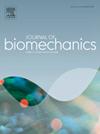Experimental assessment of CO2 rebreathing in closed-circuit CPAP therapy with different non-invasive interfaces
IF 2.4
3区 医学
Q3 BIOPHYSICS
引用次数: 0
Abstract
Continuous Positive Airway Pressure (CPAP) is a non-invasive ventilation therapy that supports respiratory function by improving functional residual capacity and maintaining open airways through positive pressure. Closed-circuit CPAP configurations are emerging as a promising alternative to conventional open circuits, offering several advantages. However, their effectiveness can be compromised by CO2 rebreathing. This study aimed to quantify inhaled CO2 levels during closed-circuit CPAP therapy with different interfaces and explore the effects of interface volume, inlet and outlet port position and airflow rates on CO2 accumulation.
Four helmets, differing in port positioning, and One-port and Two-ports total-face Masks were tested under three flow conditions (0, 60, and 80 l/min) using an ad hoc test bench to measure CO2 accumulation inside the interface.
Results demonstrated that interface design strongly influenced CO2 retention. Lateral Inlet/Lateral Outlet Helmet (current commercial helmet) showed the highest inhaled CO2 levels (about 2 %), while the Up Inlet/Front Outlet Helmet achieved lower inhaled CO2 (0.6 % at 80 l/min). Masks, characterized by smaller volumes, consistently exhibited lower CO2 retention. Notably, the Two-ports Mask maintained inhaled CO2 levels below 1 % (patient safety threshold) even without additional recirculation airflow. Increasing flow rates effectively reduced CO2 rebreathing, with the most pronounced reduction occurring between 0 and 60 l/min.
These findings highlight the critical role of interface design, particularly port positioning, in minimizing CO2 rebreathing. The results enabled selection of safe interfaces for closed-circuit CPAP. Furthermore, these findings can be extended to conventional open-circuit CPAP therapy, enhancing patient safety in non-invasive ventilation.
不同无创接口闭式CPAP治疗CO2再呼吸的实验评价
持续气道正压通气(CPAP)是一种无创通气疗法,通过正压通气改善功能残余容量,维持气道开放,支持呼吸功能。闭路CPAP配置正在成为传统开路的有希望的替代方案,具有几个优点。然而,它们的效果可能会受到二氧化碳再呼吸的影响。本研究旨在量化不同界面的闭式CPAP治疗过程中吸入的CO2水平,并探讨界面体积、进出口口位置和气流速率对CO2积累的影响。在三种流量条件下(0、60和80 l/min),使用一个特别的测试平台测试了四个端口位置不同的头盔,以及单端口和双端口全面罩,以测量界面内的二氧化碳积累。结果表明,界面设计对CO2滞留有很大影响。侧进/侧出头盔(目前的商用头盔)的二氧化碳吸入量最高(约2%),而上进/前出头盔的二氧化碳吸入量较低(80l /min时为0.6%)。口罩的特点是体积更小,始终表现出较低的二氧化碳潴留。值得注意的是,即使没有额外的再循环气流,双端口口罩也能将吸入的二氧化碳水平维持在1%以下(患者安全阈值)。增加流量可以有效减少CO2再呼吸,在0 ~ 60l /min之间减少幅度最大。这些发现强调了界面设计的关键作用,特别是端口定位,以减少二氧化碳再呼吸。结果使能选择安全接口的闭路CPAP。此外,这些发现可以扩展到常规开路CPAP治疗,提高患者在无创通气中的安全性。
本文章由计算机程序翻译,如有差异,请以英文原文为准。
求助全文
约1分钟内获得全文
求助全文
来源期刊

Journal of biomechanics
生物-工程:生物医学
CiteScore
5.10
自引率
4.20%
发文量
345
审稿时长
1 months
期刊介绍:
The Journal of Biomechanics publishes reports of original and substantial findings using the principles of mechanics to explore biological problems. Analytical, as well as experimental papers may be submitted, and the journal accepts original articles, surveys and perspective articles (usually by Editorial invitation only), book reviews and letters to the Editor. The criteria for acceptance of manuscripts include excellence, novelty, significance, clarity, conciseness and interest to the readership.
Papers published in the journal may cover a wide range of topics in biomechanics, including, but not limited to:
-Fundamental Topics - Biomechanics of the musculoskeletal, cardiovascular, and respiratory systems, mechanics of hard and soft tissues, biofluid mechanics, mechanics of prostheses and implant-tissue interfaces, mechanics of cells.
-Cardiovascular and Respiratory Biomechanics - Mechanics of blood-flow, air-flow, mechanics of the soft tissues, flow-tissue or flow-prosthesis interactions.
-Cell Biomechanics - Biomechanic analyses of cells, membranes and sub-cellular structures; the relationship of the mechanical environment to cell and tissue response.
-Dental Biomechanics - Design and analysis of dental tissues and prostheses, mechanics of chewing.
-Functional Tissue Engineering - The role of biomechanical factors in engineered tissue replacements and regenerative medicine.
-Injury Biomechanics - Mechanics of impact and trauma, dynamics of man-machine interaction.
-Molecular Biomechanics - Mechanical analyses of biomolecules.
-Orthopedic Biomechanics - Mechanics of fracture and fracture fixation, mechanics of implants and implant fixation, mechanics of bones and joints, wear of natural and artificial joints.
-Rehabilitation Biomechanics - Analyses of gait, mechanics of prosthetics and orthotics.
-Sports Biomechanics - Mechanical analyses of sports performance.
 求助内容:
求助内容: 应助结果提醒方式:
应助结果提醒方式:


